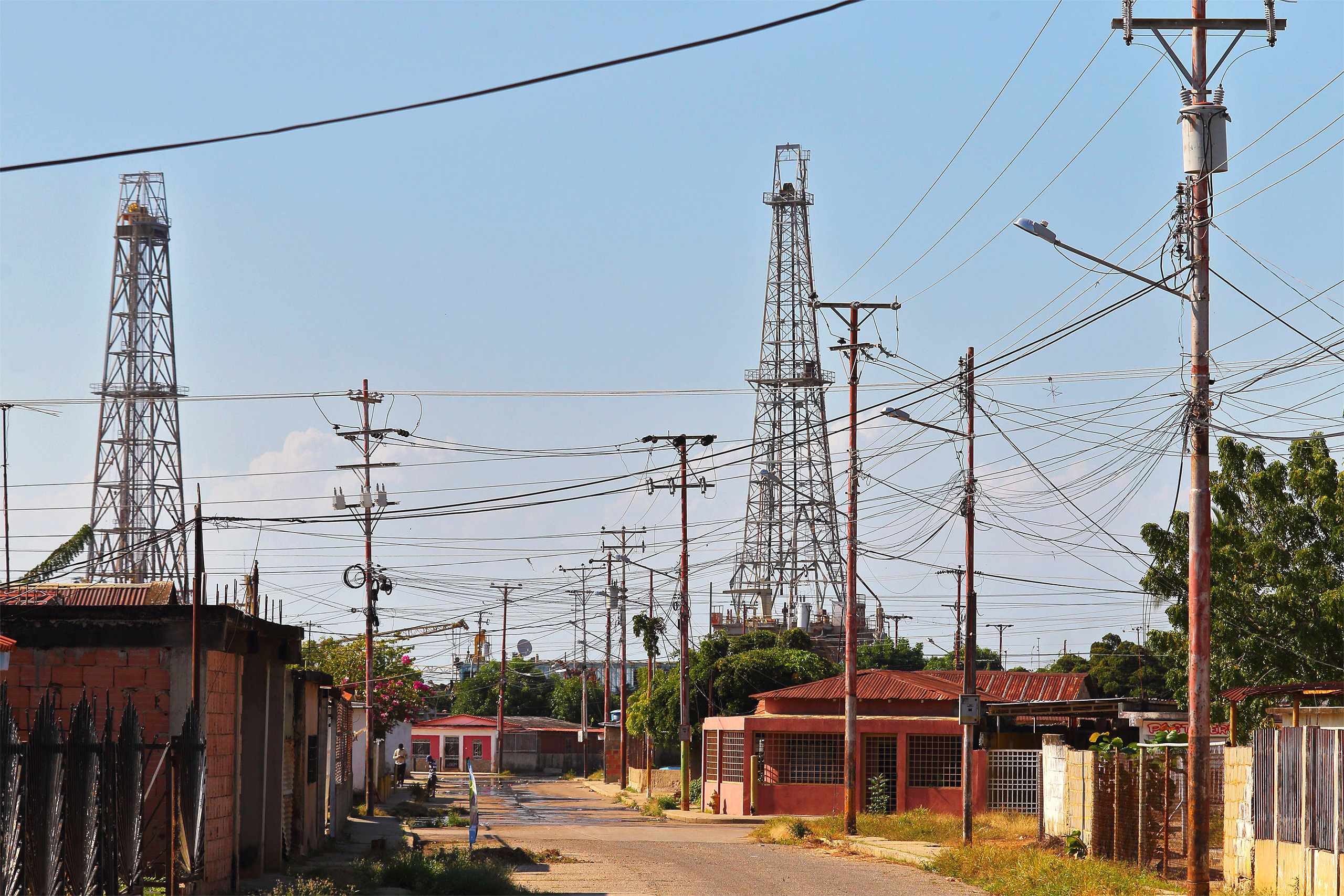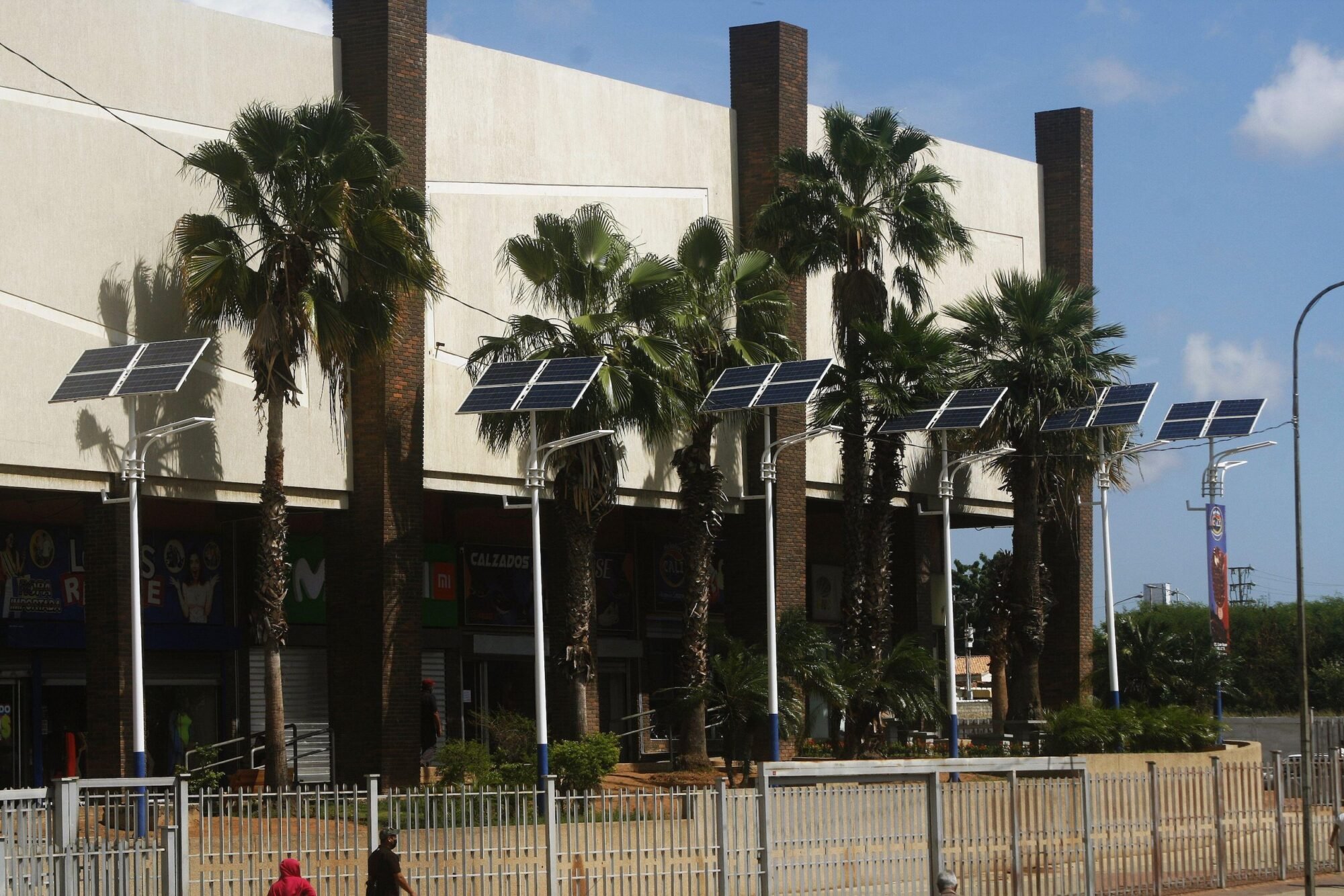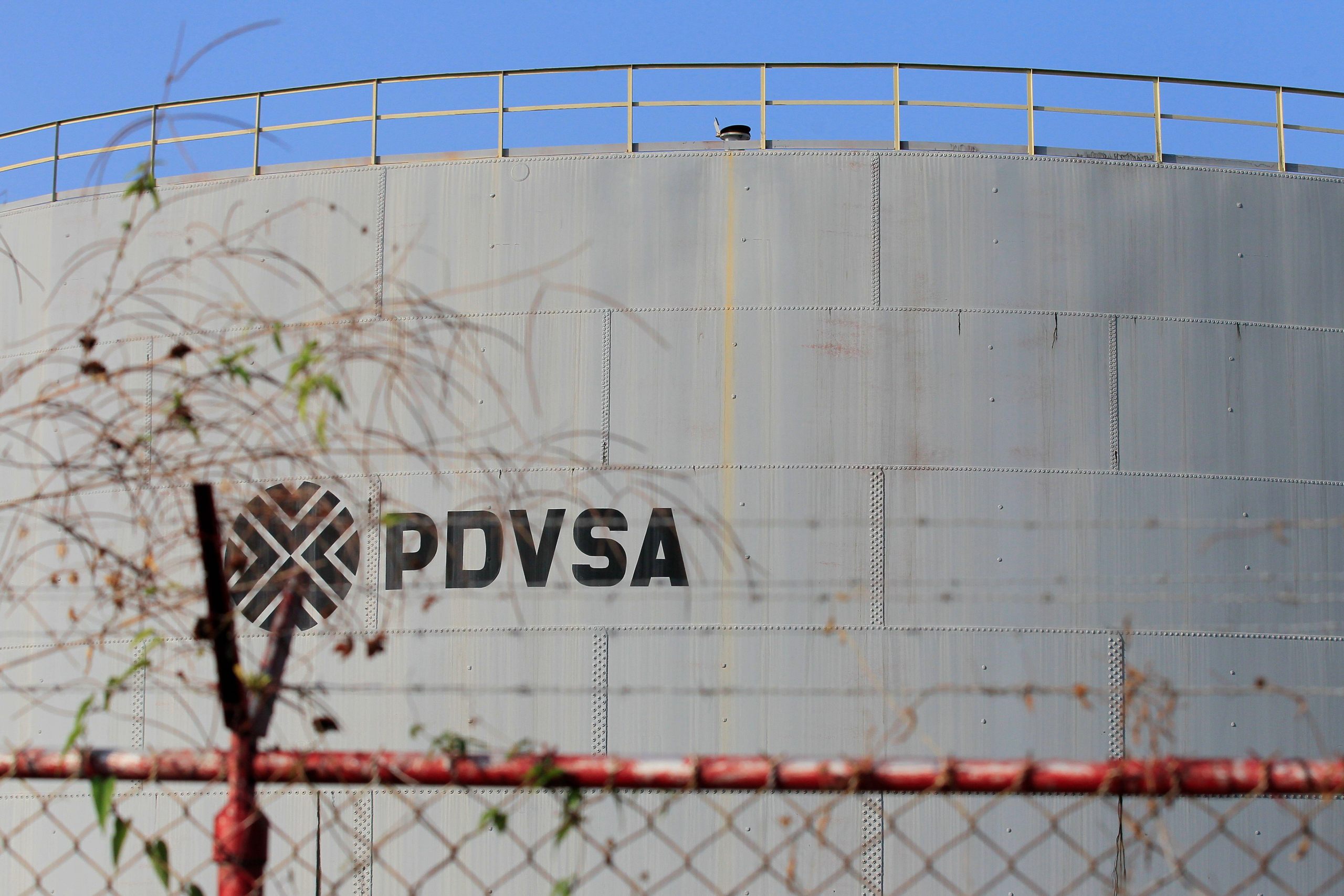During the 2010s, Venezuela took what might appear to be a giant leap towards decarbonisation. The Caribbean country’s carbon dioxide emissions from fossil fuels and industry were cut by a third, falling from over 198 million tonnes per year in 2013, to just under 62 million tonnes in 2020, according to data from the Global Carbon Budget report.
However, this huge decline is not a sign of a government-driven clean energy push.
“There was a decrease in greenhouse gases, but it was not related to public policy, but to a drop in oil production – much exacerbated by the introduction of sanctions from the United States in 2019,” explains Christi Rangel Guerrero, an economist and researcher for the anti-corruption NGO Transparency Venezuela.
Some of these sanctions apply to PDVSA, the Venezuelan state-owned oil company. These restrictions prohibit it from exporting crude oil to the US, and from buying supplies from US companies to support gasoline production. Issued by the US Treasury Department, the sanctions caused Venezuelan oil production – which was already struggling due to falling investment and losses of skilled personnel – to plummet.
According to data compiled by the Organization of the Petroleum Exporting Countries (OPEC), Venezuela’s daily oil output fell from approximately 2.32 million barrels in December 2013 to 786,000 barrels in December 2023. This, as Rangel highlights, is the main reason for Venezuela’s falling carbon emissions.
However, Venezuela’s dependence on oil does not seem to be waning: President Nicolás Maduro’s administration is searching for new oil partnerships abroad; three-year-old climate change bills are crawling through parliament; meanwhile, businesses and individuals are turning to fossil fuelled-generators for their electricity.
The first challenge: Thermoelectric plants
Rangel lives in Mérida. Situated in the west of Venezuela, in the Andean region, the city is known for its mountain scenery – and, by many, for its constant power failures. Merideños can face daily power cuts that range from four to 12 hours, owing to a lack of investment in power infrastructure, and a sector undermined by widespread corruption, beset by opaque bidding processes and billions lost in irregular payments.
As Venezuela’s oil production has fallen, so too has state investment to maintain its electricity service. Power cuts have been occurring in Mérida for more than a decade.
To overcome the often daily outages, companies, businesses and even households have resorted to buying thermoelectric generators that run on fossil fuels – a practice also common in other Andean states such as Táchira and Trujillo, which Mérida sits between, as well as in Carabobo and Lara, where Venezuela’s largest industries are located.
A recent survey of 228 companies affiliated with the Venezuelan Confederation of Industrialists (Conindustria) reported that 80.5% were bypassing the grid with a petrol or diesel generator by the end of 2023; another 9% were using a methane gas-powered generator.
While this data is useful for understanding how industry is plugging energy gaps, establishing the resulting carbon footprint is elusive.
“To achieve a more precise figure [on the use and fuel consumption of generators], it would be necessary to gather information from the field,” Juan Carlos Sánchez, a Venezuelan environmental consultant and Intergovernmental Panel on Climate Change co-author, tells Dialogue Earth.
The current total consumption of fossil-fuelled generators, either in the private or public sector, is unknown.
What has been clear in recent decades is that thermal, fossil-fuelled power has been gaining ground in Venezuela’s electricity mix, though this remains dominated by hydropower.
According to an official submission made to the United Nations in 2005, its “First National Communication on Climate Change in Venezuela”, the country produced over 60,000 gigawatt-hours of electricity from hydropower in 2001, while fossil fuel-based production reached 28,000 GWh. Its second report from 2017 – the most recent official data – showed that, by 2010, fossil fuels accounted for nearly 40,000 GWh. Over the course of the decade, thermoelectric power’s share of electricity production had risen rose from around 25% to 34%.
The two documents showed that the share of alternative renewable sources such as wind and solar power, meanwhile, remained consistent, at less than 1%.
The challenges Venezuela has faced since 2010 have, however, brought dramatic changes in its energy sector: data from energy think-tank Ember shows that overall electricity production has decreased by around a third since its most recent peak in 2013. Alongside the fall in oil and gas production, hydropower output has also declined, but accounted for over 77% of generation in 2022; the share of solar and wind power remains well below 1%.
The country’s overall electricity consumption has also fallen in the last decade, in part due to the migration of nearly 8 million Venezuelans from their home country.
Nonetheless, lowering the amount of petrol and diesel used to produce electricity remains a key challenge in advancing the energy transition in Venezuela – but it is far from the only obstacle in the country’s relationship with fossil fuels.
PDVSA, the financial anchor
Like many other Latin American countries, Venezuela must figure out how to finance its energy transition. In addition to modernising the generation, transmission and distribution of electricity, Sánchez says the country must also reckon with the weight of its oil-producing tradition.
“Public finances are highly dependent on oil revenues,” he warns, “and this is holding back any political proposal to replace fossil fuels with renewable energies, because the hegemony of oil interest groups persists.”
The Maduro government expects PDVSA revenue to provide 58% of its 2024 spending budget, according to leaked documents obtained by Reuters. Under the weight of US sanctions, the company’s primary ambition in recent years has been to seek new foreign partners to boost its oil and gas production. A state-led plan for its decarbonisation, however, is yet to materialise.
In November 2023, the Natural Resource Governance Institute released an assessment of 21 national oil companies (NOCs) from around the world. Its findings for PDVSA included that it has no public plans for decarbonisation or clean energy investment. In fact, “PDVSA, LNOC [Libya], GNPC [Ghana] and Pemex [Mexico] are the only NOCs analyzed that have not mentioned intentions or plans to invest in renewable energy.”
Furthermore, assessments found that PDVSA does not “reference ESG [environmental, social and governance] standards as relevant for [its] business plans” either. Its most recent financial and environmental report dates from 2016 and includes little information to assess its role in addressing climate change.
Companies are increasingly expected to devise and report upon environmental, social and governance standards. These three areas aim to cover what the professional services network Deloitte defines as: “all the non-financial risks and opportunities inherent to a company’s day-to-day activities”.
The principle behind ESG is that companies do not exist solely for the generation of profits. Every company is a collection of people who have the potential and responsibility to protect and nourish the environment, prioritise human wellbeing, and govern themselves ethically.
ESG reporting differs from company to company, but the relevant data is typically gathered and added to annual reports or presented as a separate sustainability report.
Rangel led an investigation by Transparencia Venezuela into PDVSA’s performance on ESG criteria, and says their review found “generic and partial data” on only 13% of the indicators it analysed. The company “says that carbon dioxide and methane emissions are below the norm, but it doesn’t say exactly how much.”
With no public plans to decarbonise, nor recent ESG reports, PDVSA’s current objective is to renegotiate its agreements with oil majors. The company hopes to boost its operations in Venezuela’s oil-rich Orinoco Belt and return production to above one million barrels per day.
Recent PDVSA deals include signings with Spain’s Repsol, France’s Maurel & Prom, and US firm Chevron – whose licence to partner with its Venezuelan counterpart remains authorised, despite the US government reimposing sanctions in April, following their short-lived easing since last October.
PDVSA is also in fresh negotiations with Chinese oil companies. At the end of January, the Chinese ambassador to Caracas, Lan Hu, held a meeting with PDVSA’s then-president Pedro Tellechea – since appointed as Venezuela’s petroleum minister. Tellechea said they met to review the “positive evolution of bilateral energy cooperation” and evaluate “new opportunities for cooperation”. No details were provided of any agreements reached.
China was the main importer of Venezuelan crude oil in 2023. According to an analysis of internal PDVSA documents and London Stock Exchange shipping data conducted by Reuters, average daily Venezuelan crude oil exports to China during 2023 were 695,192 barrels; China accounted for approximately 65% of Venezuela’s total shipments.
Climate laws in the pipeline
The legal framework for the energy transition in Venezuela is also undefined. A renewable and alternative energies bill has been awaiting discussion in the country’s national assembly since 2021. The bill could open the door to private investment in the renewables sector, but its first debate in Venezuela’s legislative plenary is yet to take place.
Perhaps the only concrete advance is the establishment of Venezuela’s National Registry of Alternative Energy Certification (Renacea). Proposed in the draft text of the renewable and alternative energies bill, it certifies the work and proficiency of energy technicians, professionals and businesses in the renewable industry.
We must form a civil society alliance for the energy transition, because we are not just talking about stopping oil productionAntonio De Lisio, geographer and researcher at the Central University of Venezuela (UCV)
Other legislative projects that appear to be stalled in Venezuela’s parliament include climate change and green hydrogen laws, which will be fundamental if it is to access international green financing; funding is a huge obstacle to the energy transition in a country still recovering from a decade of economic collapse.
“The World Bank has green bonds, the IDB [Inter-American Development Bank] has a fund for the Amazon and the CAF [Development Bank of Latin America] has a carbon market initiative. Venezuela has not made a single project in these financing options,” says Rangel.
Antonio De Lisio, a geographer and researcher in development studies at the Central University of Venezuela (UCV), tells Dialogue Earth that a wider, more profound debate on the country’s energy transition is needed: “The problem of energy transition should not be left to PDVSA alone. We must form a civil society alliance for the energy transition, because we are not just talking about stopping oil production.” He points towards wider efforts needed beyond the electricity sector, in areas such as raising awareness around the use of public transport.











